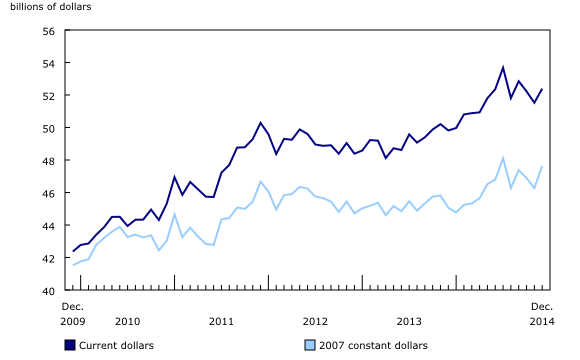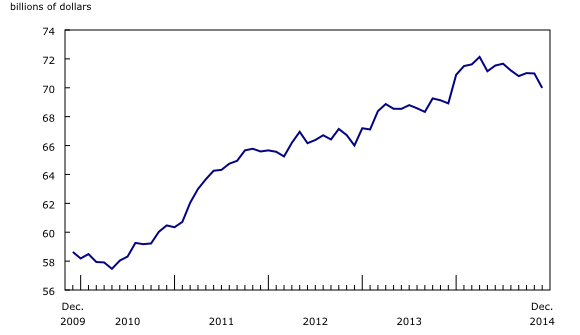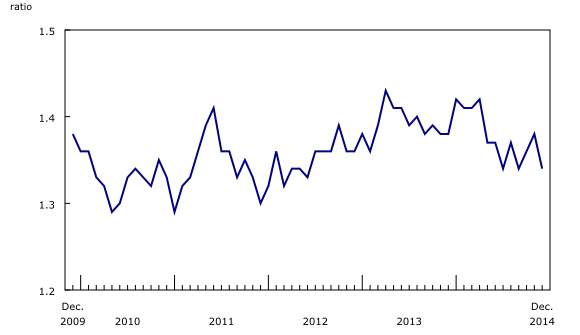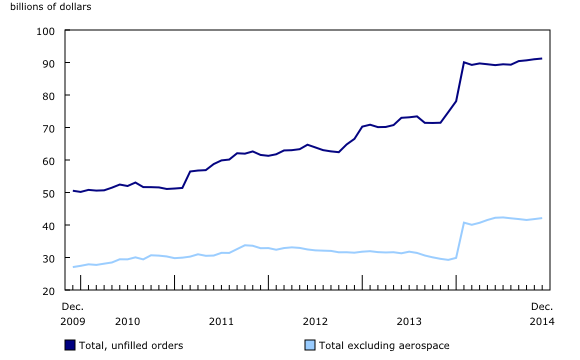Monthly Survey of Manufacturing, December 2014
Archived Content
Information identified as archived is provided for reference, research or recordkeeping purposes. It is not subject to the Government of Canada Web Standards and has not been altered or updated since it was archived. Please "contact us" to request a format other than those available.
Released: 2015-02-13
Manufacturing sales rose 1.7% in December, despite a 9.3% drop in sales of petroleum and coal products. Excluding the petroleum and coal product industry, manufacturing sales were up 3.2%. The gain reflected higher sales in the transportation equipment industry, in part, due to seasonal movements in the motor vehicle and motor vehicle parts sub-industries. Sales also rose in the machinery industry.
Overall, sales were higher in 17 of 21 industries, representing nearly 80% of total Canadian manufacturing.
Constant dollar sales were up 2.9%, indicating that a higher volume of products was sold over the course of the month. The larger increase in constant dollar sales versus current dollar sales reflects a sharp drop in prices for refined petroleum products.
Manufacturing sales up despite decline in petroleum and coal product industry
Sales in the petroleum and coal product industry fell 9.3% in December, the sixth consecutive drop. Since June 2014, sales have fallen 24.1% to $5.8 billion.
The volume of petroleum and coal products sold actually increased in December, as refineries that had undergone maintenance and turnaround work in the fall continued to ramp up production. However, an 11.6% decline in prices as reported by the Industrial Product Price Index erased all of those volume gains and resulted in the large decline.
Gains in the manufacturing sector were largely driven by increases in the transportation equipment industry, particularly the motor vehicle assembly and motor vehicle parts industries. Sales of motor vehicles rose 9.0% in December after falling 3.8% in November. Normally, there are widespread declines in the motor vehicle assembly industry in December, but this year the declines were not as steep as usual and not all large manufacturers reported declines. This led to the gain in the seasonally adjusted sales. December was also busier than usual in the motor vehicle parts industry, with seasonally adjusted sales up 4.9% as reported declines were less than normal.
Sales of machinery grew 5.2% in December to their highest level since November 2011. The gain stemmed in part from increased sales in the mining and oil and gas field equipment industry. The gains in the sub-industry occurred despite the significant drop in oil prices. Some types of machinery in the mining and oil and gas field equipment industry take many months to manufacture. As such, the gains in December partly reflect the delivery of orders placed several months ago.
Food sales rose 1.8% in December, offsetting a 1.7% decline in November. Sales of chemical products increased 2.5%, following four months of declines.
Sales increase in seven provinces
Sales increased in seven provinces in December, led by Ontario, Quebec and British Columbia.
The 2.3% sales increase in Ontario reflected gains in the transportation equipment and machinery industries. Overall, 16 of 21 industries reported higher sales in December, representing 77.7% of total manufacturing in the province. Sales in Ontario were 5.9% higher in December 2014 than in December 2013.
Sales in Quebec rose 1.5% in December, as a result of widespread gains in the food and primary metals industries. In both instances, numerous respondents reported higher sales. The gain was partially offset by a drop in petroleum and coal products.
British Columbia manufacturers reported that sales were up 2.9% in December. Gains were reported by 14 of 21 industries. The largest gains came in the wood product industry, where sales grew 4.8% in December.
Meanwhile, sales were down 4.0% in Saskatchewan and 0.8% in Alberta. In Alberta, lower sales in the petroleum and coal product industry were partly offset by an increase in machinery sales.
Inventories fall
Inventories fell 1.4% in December as a result of lower stocks in the petroleum and coal product and motor vehicle industries.
Inventory reductions in the petroleum and coal product industry were driven largely by a 17.0% drop in raw material prices, and a decline in finished product prices, as indicated by an 11.6% decrease in the Industrial Product Price Index for the industry. While nominal inventories fell in all three stages of production, volumes of inventories actually rose for raw materials and finished products.
Motor vehicle manufacturers reduced their inventories by 22.2%, after rising 19.7% over the previous five months. Inventories in the industry were at their lowest level since September 2013.
Partially offsetting the declines was a 2.3% increase in fabricated metal product inventories.
The inventory-to-sales ratio declined from 1.38 in November to 1.34 in December. The inventory-to-sales ratio measures the time, in months, that would be required to exhaust inventories if sales were to remain at their current level.
Unfilled orders rise
Unfilled orders rose 0.3% in December, the fourth consecutive monthly increase. The increase reflected higher orders in the transportation equipment (+0.4%) and computer and electronic product industries (+4.0%).
Orders rose in the railroad rolling stock industry, reflecting higher demand for rail cars in North America as a result of proposed new regulations in the industry.
New orders rose 1.5% in December, reflecting a 10.0% increase in new orders in the transportation equipment industry.
Note to readers
Monthly data in this release are seasonally adjusted and are expressed in current dollars unless otherwise specified. For more information on seasonal adjustment, please refer to the following document: Seasonally adjusted data – Frequently asked questions.
With this release, data for the previous three months have been revised.
The analytical article "Manufacturing at a Glance: Oil and gas field machinery manufacturing" is now available as part of The Daily for December 4, 2014.
Non-durable goods industries include food, beverage and tobacco products, textile mills, textile product mills, clothing, leather and allied products, paper, printing and related support activities, petroleum and coal products, chemicals, and plastics and rubber products.
Durable goods industries include wood products, non-metallic mineral products, primary metal, fabricated metal products, machinery, computer and electronic products, electrical equipment, appliances and components, transportation equipment, furniture and related products and miscellaneous manufacturing.
Production-based industries
For the aerospace industry and shipbuilding industries, the value of production is used instead of sales of goods manufactured. This value is calculated by adjusting monthly sales of goods manufactured by the monthly change in inventories of goods in process and finished products manufactured.
Unfilled orders are a stock of orders that will contribute to future sales assuming that the orders are not cancelled.
New orders are those received whether sold in the current month or not. New orders are measured as the sum of sales for the current month plus the change in unfilled orders from the previous month to the current month.
Manufacturers reporting in US dollars
Some Canadian manufacturers report sales, inventories and unfilled orders in US dollars. These data are then converted to Canadian dollars as part of the data production cycle.
For sales, based on the assumption that they occur throughout the month, the average monthly exchange rate for the reference month (noon spot rate) established by the Bank of Canada is used for the conversion. The monthly average exchange rate is available on CANSIM Table 176-0064.
Inventories and unfilled orders are reported at the end of the reference period. Therefore, for these variables, the noon spot exchange rate on the last working day of the month is used for the conversion. The noon spot exchange rate is available on CANSIM Table 176-0067. Note that because of exchange rate fluctuations, the monthly average exchange rate can differ substantially from the exchange rate on the last working day of the month.
Data from the January Monthly Survey of Manufacturing will be released on March 17.
Contact information
For more information, contact us (toll-free 1-800-263-1136; 514-283-8300; infostats@statcan.gc.ca).
To enquire about the concepts, methods or data quality of this release, contact Jeff Paul (613-951-7328; jeff.paul@statcan.gc.ca), Manufacturing and Wholesale Trade Division.
- Date modified:





